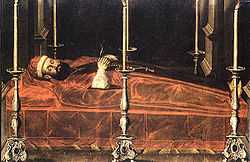Catafalque

A catafalque is a raised bier, box, or similar platform, often movable, that is used to support the casket, coffin, or body of the deceased during a funeral or memorial service.[1] Following a Roman Catholic Requiem Mass, a catafalque may be used to stand in place of the body at the Absolution of the dead or used during Masses of the Dead and All Souls Day.[2]
The term originates from the Italian catafalco, which means scaffolding.[3] The most notable Italian catafalque was the one designed for Michelangelo by his fellow artists in 1564.[4] An elaborate and highly decorated roofed surround for a catafalque,[5] common for grand funerals of the Baroque era, may also be called a castrum doloris.
Lincoln Catafalque

In the United States, the Lincoln catafalque,[6] first used for Abraham Lincoln's funeral in 1865, has been used for all those who have lain in state in the Capitol Rotunda since Lincoln's death. When not in use, the catafalque is kept on display in the Exhibition Hall at the United States Capitol Visitor Center.
Lincoln's catafalque was last used on June 6, 2013 for Senator Frank Lautenberg of New Jersey.
It was noted by commentators that the structure of the original pine timbers and boards has been reinforced, albeit being left 'original'.[7]
Notes
- ↑ Christopher Jobson (2009). Looking Forward Looking Back: Customs and Traditions of the Australian Army. Big Sky Publishing. pp. 71–. ISBN 978-0-9803251-6-4.
- ↑ James Empereur; Eduardo Fernández (12 October 2006). La Vida Sacra: Contemporary Hispanic Sacramental Theology. Rowman & Littlefield Publishers. pp. 294–. ISBN 978-1-4616-3855-1.
- ↑ Peter Stanford (23 May 2013). How to Read a Graveyard: Journeys in the Company of the Dead. A&C Black. pp. 244–. ISBN 978-1-4411-7977-7.
- ↑ Sally J. Cornelison (2012). Art and the Relic Cult of St. Antoninus in Renaissance Florence. Ashgate Publishing, Ltd. pp. 276–. ISBN 978-0-7546-6714-8.
- ↑ George Bull (15 July 1998). Michelangelo: A Biography. St. Martin's Press. pp. 3–. ISBN 978-0-312-18746-0.
- ↑ William Turner Coggeshall (1865). Lincoln Memorial: The Journeys of Abraham Lincoln: from Springfield to Washington, 1861, as President Elect; and from Washington to Springfield, 1865, as President Martyred; Comprising an Account of Public Ceremonies on the Entire Route, and Full Details of Both Journeys. Ohio State Journal. pp. 277–.
- ↑ According to Robert Cromie in his book The Great Chicago Fire, copyright 1958, Lincoln's catafalque was in Woods' Museum in Chicago and was burned in that fire in 1871. However, Lincoln had funeral ceremonies during stops at several major cities as his remains were taken by train from Washington to Springfield, Illinois for burial. Cromie probably meant the catafalque used for ceremonies held at Chicago, rather than the one built for his state funeral in DC and retained at the U.S. Capitol.
External links
| Look up catafalque in Wiktionary, the free dictionary. |
| Wikimedia Commons has media related to Catafalque. |